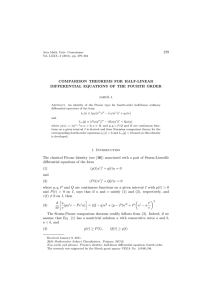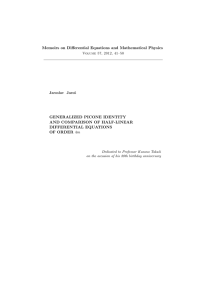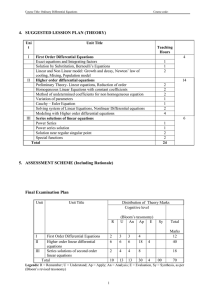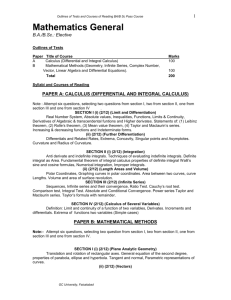COMPARISON THEOREMS FOR HALF-LINEAR DIFFERENTIAL EQUATIONS OF THE FOURTH ORDER
advertisement
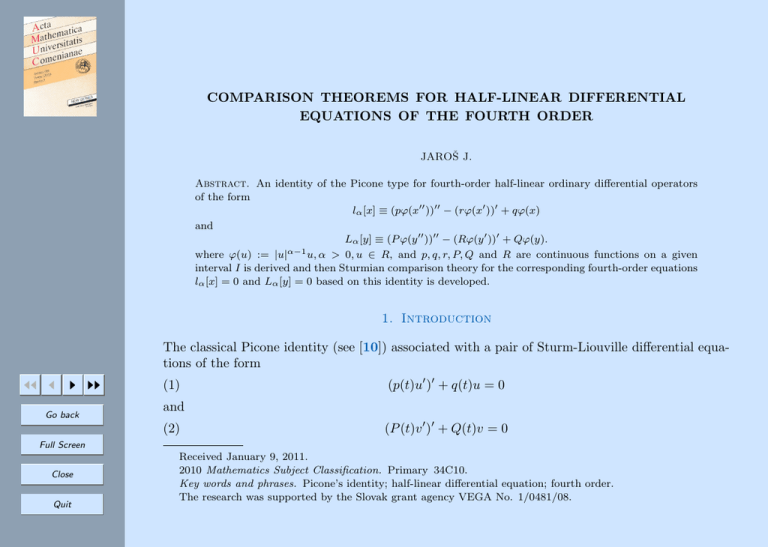
COMPARISON THEOREMS FOR HALF-LINEAR DIFFERENTIAL EQUATIONS OF THE FOURTH ORDER JAROŠ J. Abstract. An identity of the Picone type for fourth-order half-linear ordinary differential operators of the form lα [x] ≡ (pϕ(x00 ))00 − (rϕ(x0 ))0 + qϕ(x) and Lα [y] ≡ (P ϕ(y 00 ))00 − (Rϕ(y 0 ))0 + Qϕ(y). α−1 where ϕ(u) := |u| u, α > 0, u ∈ R, and p, q, r, P, Q and R are continuous functions on a given interval I is derived and then Sturmian comparison theory for the corresponding fourth-order equations lα [x] = 0 and Lα [y] = 0 based on this identity is developed. 1. Introduction The classical Picone identity (see [10]) associated with a pair of Sturm-Liouville differential equations of the form JJ J I II Go back (1) (p(t)u0 )0 + q(t)u = 0 and (2) (P (t)v 0 )0 + Q(t)v = 0 Full Screen Close Quit Received January 9, 2011. 2010 Mathematics Subject Classification. Primary 34C10. Key words and phrases. Picone’s identity; half-linear differential equation; fourth order. The research was supported by the Slovak grant agency VEGA No. 1/0481/08. where p, q, P and Q are continuous functions on a given interval I with p(t) > 0 and P (t) > 0 on I, says that if u and v satisfy (1) and (2), respectively, and v(t) 6= 0 on I, then (3) 2 d u v0 (pu0 v − P v 0 u) = (Q − q)u2 + (p − P )u02 + P u0 − u . dt v v The Sturm-Picone comparison theorem readily follows from (3). Indeed, if we assume that Eq. (1) has a nontrivial solution u with consecutive zeros a and b, a < b, and (4) p(t) ≥ P (t), Q(t) ≥ q(t) on [a, b], then integrating (3) on [a, b] we get that Eq. (2) cannot possess a solution v which is nonzero in (a, b), except in the special case where p(t) ≡ P (t) and q(t) ≡ Q(t) and v is a constant multiple of u on [a, b]. In [3] (see also [4]), the identity (3) was generalized to the case of the half-linear differential equations JJ J I II (5) Go back and Full Screen (6) Close Quit (p(t)ϕ(u0 ))0 + q(t)ϕ(u) = 0 (P (t)ϕ(v 0 ))0 + Q(t)ϕ(v) = 0, where ϕ(u) := |u|α−1 , u ∈ R, α > 0, and p, q, P and Q are continuous functions on an interval I with p(t) > 0 and P (t) > 0 on I. If u and v satisfy (5) and (6), respectively, with v(t) 6= 0 on I, then d u ϕ(v)pϕ(u0 ) − ϕ(u)P ϕ(v 0 ) dt ϕ(v) = (Q − q)|u|α+1 + (p − P )|u0 |α+1 " 0 α+1 0 # uv uv 0 0 α+1 − (α + 1)u ϕ + P |u | + α . v v (7) The half-linear generalization of Sturm-Picone comparison principle obtained previously in [1], [9] and [11] by different methods, now easily follows from (7) if we assume that the inequalities (4) hold on [a, b], where a and b are consecutive zeros of u, and use the Young inequality to show that the last expression in (7) is nonnegative with the equality holding if and only if u and v are proportional on [a, b]. Actually, the following more general result is true. Theorem A (Leighton-type comparison). If there exists a nontrivial solution u of (5) such that u(a) = u(b) = 0 and Z b (p(t) − P (t))|u0 (t)|α+1 + (Q(t) − q(t))|u(t)|α+1 dt ≥ 0, (8) a JJ J I II Go back then every solution v of (7) has at least one zero in (a, b) except in the special case when p(t) ≡ P (t), q(t) ≡ Q(t) and u(t) = cv(t) on [a, b] for some constant c. The situation in the case of fourth-order linear differential equations of the form Full Screen Close Quit (9) (p(t)u00 )00 + q(t)u = 0 and (10) (P (t)v 00 )00 + Q(t)v = 0 is more complicated. If u is a nontrivial solution of [9] on an interval [a, b] satisfying u(a) = u0 (a) = u(b) = u0 (b) = 0 (11) and if p(t) ≥ P (t), (12) q(t) ≥ Q(t) for t ∈ [a, b] then, in general, it is not true that an arbitrary solution v of [10] (or any of its derivatives) has a zero in [a, b]. This is the consequence of the result of Leighton and Nehari (see [8]) which asserts that if Q(t) < 0 for t ≥ a and v is a solution of [10] generated by the initial conditions v(a) ≥ 0, v 0 (a) ≥ 0, v 00 (a) ≥ 0 and (P v 00 )0 (a) ≥ 0 v 0 (t) > 0, v 00 (t) > 0 and (P v 00 )0 (t) > 0 (but not all zero), then v(t) > 0, JJ J I II Go back for all t > a. Thus, neither the solution v itself nor any of its derivatives v 0 , v 00 and (P v 00 )0 can vanish at the point greater than a. However, a sort of the Sturm-Picone comparison result can be obtained for [9] and [10] if we consider only solutions v of [10] for which v 0 and (P v 00 )0 have opposite signs. Full Screen Close Quit Theorem B. Let u be a nontrivial solution of [9] satisfying (11). If v is a solution of [10] for which v 0 and (P v 00 )0 have opposite signs and if the inequalities (12) hold on [a, b], then v, v 0 or (P v 00 )0 has a zero in [a, b]. (See [5].) The key tool in proving the above theorem was the Picone-type identity which asserts that if u and v are solutions of [9] and [10], respectively, and none of v and v 0 vanish in I, then d u0 0 00 0 00 u 00 0 00 0 v(pu ) − u(P v ) v pu −u P v − dt v 0 v 0 2 u 002 2 0 00 0 u (13) = (p − P )u + (q − Q)u − v (P v ) − v0 v 0 00 2 uv + P u00 − 0 . v The following comparison theorem of the Leighton type concerning the more general fourthorder linear differential equations (p(t)u00 )00 − (r(t)u0 )0 + q(t)u = 0 (14) and (P (t)v 00 )00 − (R(t)v 0 )0 + Q(t)v = 0 (15) can be obtained as a special case of the results in [7]. JJ J I II Go back Theorem C. Suppose that there exists a nontrivial solution of (14) which satisfies (12) and Z b (16) (p − P )u2 + (r − R)u02 + (q − Q)u002 dt ≥ 0. a Full Screen Close If v satisfies (15) with P (t) ≥ 0 in (a, b), (17) v 0 [R(t)v 0 − (P (t)v 00 )0 ] ≥ 0 0 Quit and then at least one of v and v has a zero in [a, b]. R(t)v 0 − (P (t)v 00 )0 6= 0 in (a, b) The purpose of this paper is to generalize the identity (13) to the case of half-linear differential equations of the fourth order and use it in proving comparison theorems of the Sturm-Picone and Leighton type. For related results concerning the linear case see also [6] and [12]. 2. Main results Consider the operators (18) lα [x] ≡ (p(t)ϕ(x00 ))00 − (r(t)ϕ(x0 ))0 + q(t)ϕ(x) and (19) JJ J I II Go back Full Screen Close Quit Lα [y] ≡ (P (t)ϕ(y 00 ))00 − (R(t)ϕ(y 0 ))0 + Q(t)ϕ(y) where p, r, q, P , R and Q are continuous functions defined on [a, b] ⊂ I and ϕ[u] := |u|α sgn u, α > 0, as before. Let Dlα (I) (resp. DLα (I)) denote the set of all continuous functions x (resp. y) defined on I such that x (resp. y) is two times continuously differentiable on I and also (rϕ(x0 ))0 and (pϕ(x00 ))00 (resp. (Rϕ(y 0 ))0 and (P ϕ(y 00 ))00 ) exist and are continuous on I. Denote by Φα the form defined for u, v ∈ R and α > 0 by (20) Φα (u, v) := uϕ(u) + αvϕ(v) − (α + 1)uϕ(v). It follows from the Young inequality that Φα (u, v) ≥ 0 for all u, v ∈ R and the equality holds if and only if u = v. The following lemma can be verified by a direct computation. Lemma. If x ∈ Dlα (I) and y ∈ DLα (I) on an interval I and if none of y and y 0 vanish in I, then 0 d x ϕ(y 0 )pϕ(x00 ) − ϕ(x0 )P ϕ(y 00 ) dt ϕ(y 0 ) x − ϕ(y)(pϕ(x00 ))0 − ϕ(x)(P ϕ(y 00 ))0 ϕ(y) x 0 0 ϕ(y)rϕ(x ) − ϕ(x)Rϕ(y ) − ϕ(y) (21) x ϕ(x)Lα [y] − ϕ(y)lα [x] = ϕ(y) + (q − Q)|x|α+1 + (r − R)|x0 |α+1 + (p − P )|x00 |α+1 0 0 00 x x 00 x y 0 0 00 0 + P Φα x , 0 + y Rϕ(y ) − (P ϕ(y )) Φα 0 , . y y y JJ J I II Theorem 1 (Leighton-type comparison). If there exists a nontrivial u ∈ Dlα ([a, b]) such that Z b (22) ulα [u]dt ≤ 0, a Go back u(a) = u0 (a) = u(b) = u0 (b) = 0 (23) Full Screen and Close Z (24) Quit Vα [u] ≡ a b (p − P )|u00 |α+1 + (r − R)|u0 |α+1 + (q − Q)|u|α+1 dt ≥ 0, then for any v ∈ DLα ([a, b]) satisfying vLα [v] ≥ 0 in (a, b), P (t) ≥ 0, v 0 R(t)ϕ(v 0 ) − (P (t)ϕ(v 00 ))0 ≥ 0, (25) (26) R(t)ϕ(v 0 ) − (P (t)ϕ(v 00 ))0 6= 0 in (a, b), v or v 0 has a zero in [a, b]. Proof. Suppose to the contrary that there exists a function v ∈ DLα ([a, b]) satisfying the inequality (25) in (a, b) such that v(t) 6= 0 and v 0 (t) 6= in [a, b]. Integrating the identity (21) where x = u and y = v on [a, b], we obtain 0 Z b u u 0 0 00 0 (27) 0 ≥ Vα [u] + v R(t)ϕ(v ) − (P (t)ϕ(v )) Φα dt ≥ 0. , v0 v a Thus, we get JJ J I II b u0 u dt = 0. , v0 v a The assumption (26) implies that Φα (u0 /v 0 , u/v) ≡ 0 in (a, b) which means that u = cv on [a, b] for some nonzero constant c. Since u(a) = u(b) = 0 and v(t) 6= 0 on [a, b], this leads to a contradiction. The proof is complete. Z v 0 R(t)ϕ(v 0 ) − (P (t)ϕ(v 00 ))0 Φα Go back Corollary (Sturm-Picone comparison). If Full Screen Close Quit (28) p(t) ≥ P (t) > 0, r(t) ≥ R(t) and q(t) ≥ Q(t) on [a, b] and there exists a nontrivial solution u of (29) (p(t)ϕ(u00 ))00 − (r(t)ϕ(u0 ))0 + q(t)ϕ(u) = 0, a < t < b, satisfying (23), then for any solution v of the majorant equation (30) (P (t)ϕ(v 00 ))00 − (R(t)ϕ(v 0 ))0 + Q(t)ϕ(v) = 0, a < t < b, satisfying (26) in (a, b), v or v 0 must have a zero in [a, b]. 3. Disconjugacy criterion Consider Eq. (29) in an interval I. Two points a, b ∈ I are called conjugate with respect to (29) if there exists a nontrivial solution u ∈ Dlα ([a, b]) satisfying (23). Eq. (29) is called disconjugate on I if no two points of I are conjugate with respect to (29). The following disconjugacy criterion for Eq. (29) is an immediate consequence of Theorem 1. Theorem 2. Eq. (29) is disconjugate on I if there exist a half-linear differential operator Lα defined by (19) and a function v ∈ DLα (I) satisfying JJ J I II Go back (31) (32) p(t) ≥ P (t) ≥ 0, r(t) ≥ R(t) vLα [v] ≥ 0 in I, and q(t) ≥ Q(t) v(t) 6= 0 in I, and Full Screen (33) Close Quit v 0 R(t)ϕ(v 0 ) − (P (t)ϕ(v 00 ))0 > 0 in I. in I, JJ J I II Go back Full Screen Close Quit 1. Elbert A., A half-linear second order differential equation, Colloquia Mathematica Societatis János Bolyai, Qualitative Theory of Differential Equations, Szeged, 30 (1979), 153–180. 2. Jaroš J., Comparison theorems for half-linear equations of fourth order, EQUADIFF 9, Conference on Differential Equations and Their Applications, August 25–29, 1997, Abstracts and Enlarged Abstracts (Ed. by Z. Došlá, J. Kalas, J. Vosmanský), Masaryk University, Brno, p. 233. 3. Jaroš J. and Kusano T., On forced second order half-linear equations, Proceedings of the Symposium on the Structure and Methods of Functional Differential Equations, RIMS, Kokyuroku 984, Kyoto University, 1997, 191-197 (in Japanese). , A Picone-type identity for second order half-linear differential equations, Acta Math. Univ. Comeni4. anae LXVIII (1999), 137–151. 5. Kreith K., A comparison theorem for fourth order differential equations, Atti Accad. Naz. Lincei Rend. Cl. Sci. Fis. Mat. Natur. 46 (1969), 664–666. 6. , A Picone identity for fourth order differential equations, Atti Accad. Naz. Lincei Rend. Cl. Sci. Fis. Mat. Natur. 52 (1972), 455–456. 7. Kusano T. and Yoshida N., Picone’s identity for ordinary differential operators of even order, Atti Accad. Naz. Lincei Rend. Cl. Sci. Fis. Mat. Natur. 58 (1975), 524–530. 8. Leighton W. and Nehari Z., On the oscillation of solutions of selfadjoint linear differential equations of the fourth order, Trans. Amer. Math. Soc. 89 (1958), 325–377. 9. Li H. J. and Yeh C. C., Sturmian comparison theorem for half-linear second-order differential equations, Proc. Roy. Soc. Edinburgh Sect. A, 125 (1995), 1193–1204. 10. Picone M., Sui valori eccezionali di un parametro da cui dipende un’ equazione differenziale ordinaria del second ordine, Ann. Scuola Nom. Pisa II (1910), 1–141. 11. Mirzov J. D., On some analogs of Sturm’s and Kneser’s theorems for nonlinear systems, J. Math. Anal. Appl. 53 (1976), 418–425. 12. Tanigawa T. and Yoshida N., Picone identities for ordinary differential equations of fourth order, Math. J. Toyama Univ. 27 (2004), 91–99. Jaroš J., Faculty of Mathematics, Physics and Informatics, Comenius University Mlynska dolina, 842 48 Bratislava, Slovak Republic, e-mail: Jaroslav.Jaros@fmph.uniba.sk JJ J I II Go back Full Screen Close Quit
